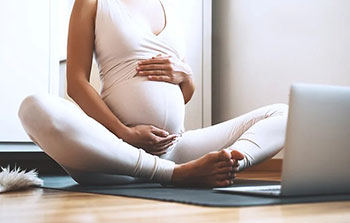 One of the most common complaints during pregnancy is foot pain and swelling. Both are very normal and extremely common. Read on to learn more about what the heck is going on, and how to stay comfortable!
One of the most common complaints during pregnancy is foot pain and swelling. Both are very normal and extremely common. Read on to learn more about what the heck is going on, and how to stay comfortable!
During pregnancy, your body increases circulation of certain hormones, like relaxin, which cause ligamentous laxity.
Your feet may widen, lengthen, and become painful from the stretch in your ligaments and loss of structural support. To prevent discomfort from these changes, wear supportive shoes at all times. Over-the-counter insoles or custom orthotics can help provide the arch support and cushion you need. Wide toe box athletic shoes and open toed, but supportive, sandals can help accommodate your growing feet. (Spoiler alert: your feet may never go back to their pre-pregnancy size.)
As your baby grows, your center of gravity changes, increasing the pressure on different areas on the bottom of your feet.
Protect yourself from heel pain and plantar fasciitis throughout your pregnancy by paying attention to the type of shoes you wear. Early in your pregnancy, your weight increases but your center of gravity hasn't shifted much. Shoes with padding in the ball of your feet will help accommodate the increased pressure from weight gain. Look for shoes with more substantial heel cushioning later on in your pregnancy, when your center of gravity moves backward, shifting pressure to your heels.
As your baby grows, your body holds more fluid, but also becomes less efficient at filtering and moving fluid throughout the body, leading to swelling. Here are recommendations for keeping your swelling in check throughout your pregnancy:
- Wear compression socks. Graduated compression is best, and avoid styles with a tight band at the top of the calf. Put them on first thing in the morning, before you start your day.
- Avoid standing for long periods of time. Prop up your legs without crossing them when lounging. The best position for quick relief later in pregnancy is to lie down on your left side with your legs slightly elevated.
- Try to exercise. If you have access to a pool, aquatic therapy helps reduce swelling and back pain!
- Keep cool. Try soaking your feet in cold Epsom salt bath or similar to provide some relief.
- Massage your feet and roll your ankles throughout the day. Try to massage UP the leg to decrease swelling.
- Stay hydrated. If your body thinks you're not getting enough water, it will retain more!
- Refrain from sleeping on your back during the third trimester. The weight of your baby compresses a large vein that slows your circulation, worsening swelling.
- Decrease salt intake (sorry!)
Notify your doctor when:
- You have pain only on ONE side.
- Sudden onset of swelling inconsistent with your typical "end of day" swelling.
- Swelling in only ONE leg.
